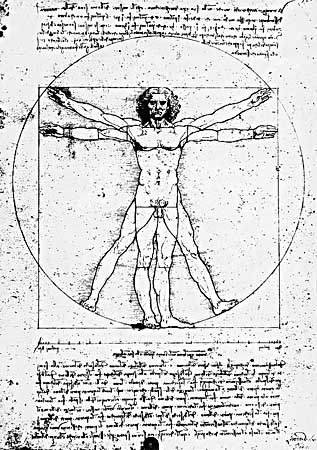golden ratio
mathematics
also known as the golden section, golden mean, or divine proportion
in mathematics, the irrational number (1+√5)/2, often denoted by the Greek letters τ or ϕ, and approximately equal to 1.618. The origin of this number and its name may be traced back to about 500 BC and the investigation in Pythagorean geometry (Pythagoreanism) of the regular pentagon, in which the five diagonals form a five-pointed star. On each such diagonal lie two points of intersection with other diagonals, and either of those points divides the whole diagonal into two segments of unequal lengths so that the ratio of the whole diagonal to the larger segment equals the ratio of the larger segment to the smaller one. In terms of present day algebra, letting the length of the shorter segment be one unit and the length of the larger segment be x units gives rise to the equation (x+1)/x=x/1; this may be rearranged to form the quadratic equation x2–x–1=0, for which the positive solution is x=(1+√5)/2, the golden ratio.
 The ancient Greeks recognized this “dividing” or “sectioning” property and described it generally as “the division of a line into extreme and mean ratio,” a phrase that was ultimately shortened to simply “the section.” It was more than 2,000 years later that both “ratio” and “section” were designated as “golden” in references by the German astronomer Johannes Kepler (Kepler, Johannes) and others. The Greeks also had observed that the golden ratio provided the most aesthetically pleasing proportion of sides of a rectangle, a notion that was enhanced during the Renaissance by, for example, work of the Italian polymath Leonardo da Vinci and the publication of De divina proportione (1509; Divine Proportion) by the Italian mathematician Luca Pacioli, and illustrated by Leonardo (see the photograph-->
The ancient Greeks recognized this “dividing” or “sectioning” property and described it generally as “the division of a line into extreme and mean ratio,” a phrase that was ultimately shortened to simply “the section.” It was more than 2,000 years later that both “ratio” and “section” were designated as “golden” in references by the German astronomer Johannes Kepler (Kepler, Johannes) and others. The Greeks also had observed that the golden ratio provided the most aesthetically pleasing proportion of sides of a rectangle, a notion that was enhanced during the Renaissance by, for example, work of the Italian polymath Leonardo da Vinci and the publication of De divina proportione (1509; Divine Proportion) by the Italian mathematician Luca Pacioli, and illustrated by Leonardo (see the photograph--> ).
).The golden ratio occurs in many mathematical contexts. It is geometrically constructible by straightedge and compass, and it occurs in the investigation of the Archimedean and Platonic solids (Platonic solid). It is the limit of the ratios of consecutive terms of the Fibonacci number (Fibonacci numbers) sequence 1, 1, 2, 3, 5, 8, 13, …, in which each term beyond the second is the sum of the previous two, and it is also the value of the most basic of continued fractions, namely 1+1/(1+ 1/(1+ 1/(1+ ….
In modern mathematics, the golden ratio occurs in the description of fractals (fractal), figures that exhibit self-similarity and play an important role in the study of chaos (chaos theory) and dynamical systems (analysis).
- Rufinus, Tyrannius
- Rufisque
- Rufus Henry Gilbert
- Rufus King
- Rufus Matthew Jones
- Rufus Putnam
- Rufus Wheeler Peckham
- Rufus Wilmot Griswold
- rug and carpet
- Rugby
- rugby
- Rugby Football League
- Rugby Football Union
- Rugby League World Cup
- Rugby Union World Cup
- Ruggero Giuseppe Boscovich
- Ruggero Leoncavallo
- Ruggiero di Lauria
- Ruggiero Ricci
- Ruggles-Brise, Sir Evelyn
- Ruggles, Carl
- Rugi
- Ruhmkorff, Heinrich Daniel
- Ruhollah Khomeini
- Ruhr